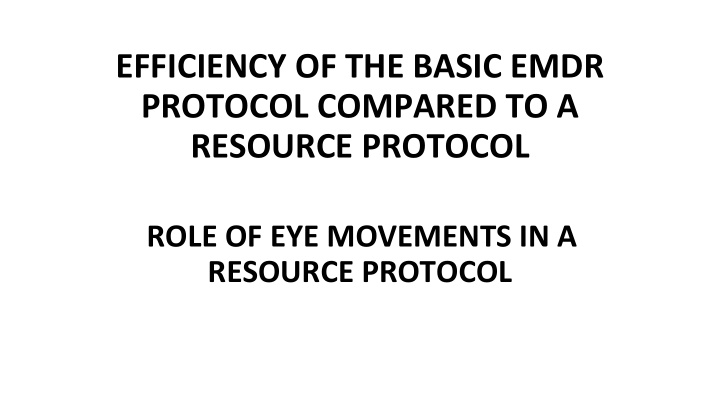



EFFICIENCY OF THE BASIC EMDR PROTOCOL COMPARED TO A RESOURCE PROTOCOL ROLE OF EYE MOVEMENTS IN A RESOURCE PROTOCOL
A comparison between one session of the standard protocol versus the reinforced resource protocol • The basic EMDR protocol • And the Reinforced resource protocol, a mix of : • traditional mental preparation • traditional resource work • and the peak performance protocol created by Foster and Lendl, enriched with positive psychology (2012) were used to help a population of students and athletes to face future anxiety-inducing challenges, in other words to treat performance anxiety, with a single session.
AIM • The aim of this study was to compare the efficiency of both protocols in reducing performance anxiety related to a future event in only one session • and to determine whether eye movements are requested or not in resource installation and development
Eye movements and Resources: Hornsveld, De Jongh & al. versus Korn and Leeds • Leeds, who created the Resource and development installation (RDI) protocol (2002, 2012), doesn't question the efficiency of eye movements (EMs) in resourcing. On the contrary, Hornsveld & al. concluded that Eye Movements are not necessary for resource development (2011, 2012). • Contrary to Hornsveld's and al. 2011 research , the present study assessed in a practical context, a real session, not a in research setting, the efficiency of eye movements in resource installation.
Design, setting and participants: • A randomized controlled trial of students (n=45), most of them professional athletes. • Participants were randomly assigned to receive only one session of: • the EMDR basic protocol, (group 1), n=15 • or the Reinforced Resource Protocol with slow eye movements, (group 2), n=15 • or the Reinforced Resource Protocol without eye movements (group 3), (basically, a visualization) n=15 • The control group : students on a waiting list, answered questionnaires through internet before the session, n= 15
Measurements: • the SUDs, • the VOC, • the well-being and quality of life (Schwartz scale, SOS-10), • the self-esteem (Rosenberg scale), • the goal attainment, • The data are collected before and just after the sessions and at a two-month follow-up.
RESULTS In every group we observed significant positive results No significative difference between the groups, except for the quality of life and well-being (Group 3 is the best) and for the stronger effects of eye movements in desensitization …
SUDs:Significant and lasting decrease in all groups
VOC: Significant and lasting increase for all groups
Lasting increase in self-esteem in all groups
Lasting increase in well-being in group n°3 only
Average time of one session
Goal attainment • 91% of the students / athletes were successful in their exams or competitions • Then all protocols helped them to reach their goal, which was confirmed by their comments • //Neurosciences explain that people can perform better when negative emotions are lower
Recommandations for mental preparation to treat performance anxiety: • If you have a lot of time: standard protocol ( … but you can also use interweaving if you want to speed … ) • If you don’t have a lot of time: use a resource protocol, whether with or without eye movements (it’s more demanding because you have to guide a visualisation!) • If you have a very anxious client, please, DO USE eye movements, otherwise it won’t work!!! (I do agree with A. Leeds on this point) This doesn’t appear in the results, but 3 of the participants in the study were very very anxious people, they didn’t see their SUDs decrease a lot in group 3: the absence of eye movement didn’t help them And someone was excluded from the study because I had to calm down her with Eye movements … .
Conclusion • We can desensitize a future stressful event with a resource protocol. (with or without eye movement). Research is needed to determine whether this could work with past traumas. • The resource protocol can work with or without eye movement (this confirms in a way Hornsveld and al.’s statements). • But on average, after two months, the SUDs is higher for group 3 (without Eye Movement): 3/10, than for group 2 (with eye movements): 1, 5/ 10. This is not a surprise as we know the desensitization effect of eye movements. Then one session of the resource protocol is more efficient with eye movements . • With very anxious or severely traumatised clients, we recommend eye movements (As Andrew Leeds underlined it) and we need more research about the use of eye movements in the resource development with these clients.
Recommend
More recommend